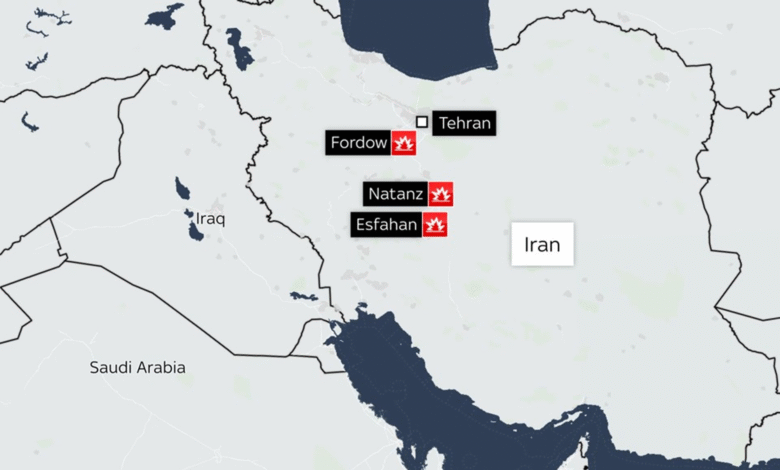Iran Nuclear Strikes: Trump Claims Major Damage Confirmed

The recent Iran nuclear strikes represent a significant escalation in the long-standing geopolitical tensions Iran faces over its nuclear program. As President Donald Trump emphasized on social media, these strikes resulted in monumental damage to key nuclear facilities, with intelligence reports suggesting severe destruction at sites like Fordo, Natanz, and Isfahan. The operation, dubbed Operation Midnight Hammer, unleashed a torrent of advanced munitions on these heavily fortified installations, revealing the intensity of U.S. commitment to curbing Iran’s nuclear ambitions. With the potential for ongoing assessments and geopolitical ramifications, the stakes have never been higher regarding Iran’s nuclear capabilities. As Washington, Tehran, and global observers analyze the implications of these strikes, the focus remains on the extent of the Iran nuclear facility damage and what it means for future international relations.
In a bold move characterized by unprecedented military action, the recent military intervention targeting Iran’s nuclear installations has sent ripples across the international landscape. The U.S. airstrikes not only aimed to dismantle Iran’s nuclear aspirations but also highlighted the intricate web of geopolitical dynamics at play in the Middle East. These operations, under the code name Operation Midnight Hammer, are reflective of heightened tensions and assertive military policy in the region. Analysts are closely monitoring the potential fallout from these strikes, which aim to mitigate threats associated with highly enriched uranium production. The discourse surrounding this incident continues to evolve as countries worldwide grapple with the implications of the U.S. action on Iran’s nuclear program and its broader effects on global security.
Impact of Trump’s Claims on Iran Nuclear Facility Damage
In a recent statement on Truth Social, former President Donald Trump made bold claims regarding the damage inflicted on Iran’s nuclear facilities following the U.S. airstrikes. He emphasized that the term “obliteration” accurately describes the extent of the devastation, citing satellite imagery as evidence. Post-strike assessments by US military officials have confirmed severe damage to sites such as Fordo, Natanz, and Isfahan; however, the true impact on Iran’s nuclear capabilities remains uncertain. While Trump promotes a narrative of complete destruction, military experts caution that definitive evaluations will take time and that the nuclear threat from Iran may not be fully neutralized.
The emphasis on monumental damage has ripple effects beyond military circles. For example, Trump’s tweets influence public sentiment and galvanize geopolitical tensions surrounding Iran’s nuclear ambitions. As the former president’s statements echo in media outlets, they foster a perception of urgency and immediate consequence regarding Iran’s nuclear capabilities. Conversely, it also raises questions about the reliability of current intelligence assessments, reminding us of the complexities involved in understanding the true state of Iran’s nuclear technology after the airstrikes.
Overview of Operation Midnight Hammer and Its Consequences
Operation Midnight Hammer, which transferred precision bombers and Tomahawk missiles into strategic positions, marked a significant escalation in U.S. military operations against Iranian nuclear facilities. Launched with the intent to curb Iran’s ability to produce weapons-grade nuclear material, the operation effectively utilized advanced weaponry such as the GBU-57 Massive Ordnance Penetrators, capable of penetrating deep underground facilities. These targeted strikes were particularly focused on the Fordo facility, known for its reinforced structure that poses challenges for aerial attacks.
As the dust settles from Operation Midnight Hammer, military analysts and international observers are keenly monitoring the fallout. With Iranian officials reportedly relocating important materials ahead of the strikes, the effectiveness of this operation could be diminished in the larger context of regional security dynamics. Furthermore, the commencement of airstrikes revitalizes ongoing geopolitical tensions in the Middle East, reinforcing the need for diplomatic engagement alongside military strategies to ensure a comprehensive resolution regarding Iran’s nuclear weapon capabilities.
Geopolitical tensions surrounding Iran’s nuclear program continue to escalate as nations grapple with the implications of military action on international diplomacy. The strikes and the reactions they invoke may precipitate a dangerous arms race in the region or prompt retaliatory actions by Iran, creating an unstable environment yet again. It is essential to consider that while effective military operations are important, long-term peace necessitates dialogues that address core security concerns without escalating hostilities.
The Role of High Stakes in U.S.-Iran Relations
The airstrikes against Iran’s nuclear facilities reflect high-stakes maneuvers in the broader context of U.S.-Iran relations, which have been fraught with tension since the nuclear deal’s collapse. The recent military actions are indicative of a larger narrative of confrontation, showcasing how the U.S. perceives its role in mitigating nuclear threats. As President Trump and his administration take a hardline stance, the potential for diplomatic resolutions diminishes, raising the stakes for both nations involved.
High-stakes diplomacy is not just about military readiness but also about understanding the implications of actions taken in these turbulent waters. The repercussions of the strikes send a powerful signal to Iran and other nations regarding the U.S.’s commitment to counteracting perceived threats. However, without a balanced approach that includes negotiation alongside military strategies, the risk of escalating conflicts increases, which could ultimately destabilize not just the region but global security as well.
Potential Outcomes of U.S. Airstrikes on Iran’s Nuclear Capabilities
As assessments of the damage caused by the U.S. airstrikes continue, several potential outcomes arise regarding Iran’s nuclear capabilities. The immediate aftermath may suggest that operations like Operation Midnight Hammer could temporarily suppress Iran’s nuclear ambitions. However, military experts warn that such limitations are often short-lived if diplomatic measures do not accompany military action. The movement of enriched uranium prior to the strikes hints at Iran’s strategic adaptability, raising concerns about the effectiveness and longevity of U.S. intervention.
On the flip side, if Iran manages to retain or expedite its nuclear program through covert means, the implications for U.S. national security and that of its allies remain dire. Enhanced geopolitical tensions could lead to a more militarized region, complete with increased diplomatic estrangement and potential for broader conflicts. This delicate balance of military action versus diplomatic dialogue underscores the intertwined nature of threats posed by nuclear advancement and the necessity for comprehensive security measures.
The Uncertainties Surrounding Damage Assessments
Following the U.S. airstrikes, the process of damage assessment becomes a critical element in understanding the efficacy of Operation Midnight Hammer. Experts have indicated that determining the full extent of damage to Iran’s nuclear facilities is complex and will require time. While initial reports suggest severe destruction at facilities such as Fordo and Natanz, military authorities have refrained from declaring a complete halt to Iran’s nuclear capabilities. This uncertainty only adds to the volatility of an already tense geopolitical situation.
In the realm of public perception, these ongoing assessments hold significant weight. As officials like U.S. Secretary of Defense Pete Hegseth have highlighted the precision of military strikes, the contrasting reports from international observers evoke skepticism on whether the intended impacts were indeed achieved. This interplay between military assertions and external verification creates an environment ripe for speculation, emphasizing that the road to transparent nuclear oversight in Iran remains fraught with challenges and tensions.
Iran’s Response to Military Action and Nuclear Strategy
In response to the U.S. airstrikes, Iran’s government has maintained a defiant stance, viewing the military action as an affront to its sovereignty. Iranian officials have indicated the relocation of significant nuclear materials in anticipation of potential strikes, reflecting a calculated strategy to safeguard their nuclear program from being completely nullified. This swift response not only showcases Iran’s resilience but also illustrates the lengths to which the regime is willing to go to retain its nuclear ambitions amid heightened external pressures.
Moreover, Iran’s strategy appears to involve both political and military dimensions, seeking to rally domestic support against perceived foreign aggressors while simultaneously maintaining its nuclear development agenda. The intersection of military action with Iran’s national identity emphasizes the complexity of resolving longstanding disputes diplomatically, illustrating how strikes may only lead to further entrenchment rather than compliance.
Geopolitical Implications of Escalating Tensions with Iran
The escalating geopolitical tensions surrounding Iran’s nuclear program create a volatile environment that extends beyond the immediate area. As nations weigh the implications of the U.S. strikes, the ripple effects on international relations and regional stability become increasingly significant. With potential fallout in areas such as energy markets and diplomatic alliances, the stakes have never been higher for global powers seeking to navigate a path forward.
The international community’s response to U.S. military action will undoubtedly shape the narrative of nuclear diplomacy in the years to come. Countries are forced to reconsider their positions on sanctions and alliances, while also contemplating the potential for an arms race or military escalation. This complicates diplomatic efforts to secure a long-lasting resolution to Iran’s nuclear ambitions, proving that the consequences of military action reach far beyond the battlefield.
Future of Diplomatic Engagement with Iran
As military tensions rise following the U.S. airstrikes, the need for renewed diplomatic engagements becomes evident. Stakeholders must comprehend that a purely military solution is insufficient for addressing the multifaceted challenges posed by Iran’s nuclear program. Diplomatic interventions are essential not only for de-escalation but also for meaningful dialogue on preventing conflict in an already charged environment.
The diplomatic avenue must be pursued alongside military posturing to reach a balanced approach, especially as both parties express their grievances and security concerns. Utilizing backchannels and international forums could provide a platform for moving beyond hostility and firmly establishing norms surrounding nuclear proliferation. A commitment to dialogue will ultimately be pivotal in charting a course towards sustained regional stability.
Frequently Asked Questions
What are the implications of the Iran nuclear strikes on geopolitical tensions in the region?
The Iran nuclear strikes, part of Operation Midnight Hammer, have heightened geopolitical tensions in the Middle East. By targeting key facilities such as Fordo, Natanz, and Isfahan, the U.S. aims to weaken Iran’s nuclear capabilities, potentially altering the balance of power in the region and fostering further conflict.
How did Trump characterize the damage caused by the Iran nuclear strikes?
President Trump characterized the damage from the Iran nuclear strikes as ‘obliteration,’ asserting that monumental damage was inflicted on Iranian nuclear sites, including the deeply embedded facilities at Fordo and others, as indicated by satellite images.
What was Operation Midnight Hammer in relation to Iran’s nuclear facilities?
Operation Midnight Hammer was a military engagement involving U.S. precision airstrikes on Iran’s nuclear facilities, including deep-target strikes using Massive Ordnance Penetrators. This operation aimed to significantly damage Iran’s nuclear capabilities amidst rising geopolitical tensions.
What were the confirmed damages at the Iran nuclear facilities post-strikes?
Post-strikes, the U.S. Chairman of the Joint Chiefs of Staff confirmed severe damage at the Fordo, Natanz, and Isfahan facilities. While exact assessments are still pending, initial reports indicate that these sites suffered extremely severe destruction, potentially impacting Iran’s nuclear program.
Has the nuclear capability of Iran been effectively destroyed by the U.S. airstrikes?
While U.S. Secretary of Defense Pete Hegseth stated that all precision munitions struck their targets during the Iran nuclear strikes, it remains too early to determine if Iran retains any nuclear capability, as comprehensive battle damage assessments are still underway.
What role did the UN nuclear watchdog play in evaluating the impact of the Iran nuclear strikes?
The head of the UN nuclear watchdog, Rafael Grossi, indicated that it is not yet possible to fully assess the impact of the Iran nuclear strikes on facilities like Fordo. This highlights the complexities involved in evaluating the damage and its implications for Iran’s nuclear program.
What types of munitions were used in the Iran nuclear strikes under Operation Midnight Hammer?
During Operation Midnight Hammer, the U.S. utilized GBU-57 Massive Ordnance Penetrators (MOP), designed for deep-target strikes, alongside Tomahawk missiles, to target Iran’s nuclear facilities effectively.
What precautionary measures were taken by Iran before the U.S. airstrikes on their nuclear facilities?
Prior to the U.S. airstrikes, reports suggest that Iran moved much of its highly enriched uranium from the Fordo facility to an undisclosed location, indicating strategic preparation to mitigate the impact of the strikes on their nuclear capabilities.
How do the Iran nuclear strikes affect international relations involving the United States?
The Iran nuclear strikes have intensified global scrutiny of U.S. military actions and foreign policy towards Iran. This escalation could affect negotiations related to nuclear non-proliferation and reshape alliances within the region amidst ongoing geopolitical tensions.
What can be expected in terms of response from Iran following the U.S. airstrikes on its nuclear facilities?
Following the U.S. airstrikes, Iran may pursue a range of responses, from diplomatic efforts to increase resistance against U.S. policies, consolidating its nuclear efforts, or even retaliatory measures, reflecting the high-stakes environment created by the ongoing geopolitical tensions.
| Key Point | Details |
|---|---|
| Trump’s Dispute over Damage Assessment | Trump characterizes the damage to Iran’s nuclear facilities as ‘obliteration’ based on satellite images, asserting that significant damage occurred. |
| Military Confirmation of Damage | Gen. Dan Caine confirms ‘severe damage’ to facilities in Fordo, Natanz, and Isfahan but avoids claiming total obliteration. |
| Effectiveness of the Strikes | Secretary of Defense Pete Hegseth states precision munitions struck intended targets, but it is too early to assess Iran’s remaining nuclear capability. |
| UN’s Position | Rafael Grossi from the UN Nuclear Watchdog states that evaluating the damage at the Fordo facility is premature. |
| Strikes on Specific Locations | Airstrikes target Fordo, Natanz, and Isfahan using B-2 bombers and Tomahawk missiles from submarines, part of Operation Midnight Hammer. |
Summary
Iran nuclear strikes have escalated tensions in the region amidst ongoing geopolitical conflicts. The strikes by U.S. forces on key Iranian nuclear facilities, including Fordo, Natanz, and Isfahan, have been described with terms like ‘obliteration’ by U.S. officials, reflecting the severity of the damage. While initial assessments indicate significant destruction, ongoing evaluations are necessary to understand the full impact on Iran’s nuclear capabilities. This military engagement underscores the complexities surrounding Iran’s nuclear ambitions and the international response to them.




